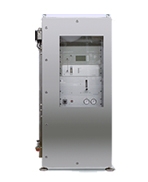|

##Fast and Reliable Results
##Detects Elemental and Bound Mercury
##Automatic Calibration
##Sample Point Multiplexer
##Sample Dilution for High Concentrations
##No Carrier Gases Required
##Certified for Hazardous Zones
Preface
Natural gas often contains mercury at concentrations that vary from below 1 to above 10000 µg/m³. Mercury is both toxic and potentially damaging: it can corrode or embrittle common gas plant components. Gas plants reduce mercury in natural gas with mercury removal units (MRUs). MRUs use fixed bed absorbers, often with sulfur-impregnated carbon or other chemisorbents as the active material. The Mercury Monitoring System is an ideal tool to determine the efficiency of each MRU in real time, and necessary to successfully monitor and control mercury concentrations during natural gas production and processing.
Continuous Measurement of Mercury in Natural Gas
Mercury Instruments has engineered a system for automatic and continuous monitoring of mercury levels in natural gas and other flammable gases. We install the mercury analyzer (and accessories such as a calibrator) in a pressurized enclosure that is approved for use even in hazardous zones (ATEX, EExP). A heated system takes the sample and guides it to the analyzer via stainless steel tubing that has been surface-treated for ultra-low adsorptivity. A built-in gas sensor will shut the system down and stop the sample gas flow if any leakage is detected.
Highly Selective and Sensitive Detector
The UT-3000 Mercury Ultratracer is used to detect and precisely measure mercury levels in natural gas. A proprietary gold collector selectively absorbs mercury from a constant sample volume. The collector is then heated for a very short period. The mercury is thus released into an optical cell and quantitatively detected using atomic absorption measurement (AAS). In contrast to atomic fluorescence systems, the UT-3000 does not require special carrier gases. Air is used as a carrier gas, thus keeping the gold surface clean and enhancing the collector lifetime compared to other systems. With the UT-3000, interference from hydrocarbons or other gaseous components is insignificant (see Benzene interference diagram).
Sampling System for Natural Gas
The integrity of the sampling system is as important as the analyzer itself. To sample natural gas from a pipeline, the sampling system must reduce pressure and guide the sample from the sampling point to the analyzer, leaving the mercury concentration unchanged. Plus it should show a minimum lag time and be suited to hard use in hazardous zones. The MMS sample conditioning system by Mercury Instruments fulfills these requirements. The surface of the pressure-reduction system is electrically heated to obviate condensation and mercury loss caused by the Joule-Thomson cooling effect. A specially coated coalescing filter effectively removes aqueous mist as well as hydrocarbon condensate. Tubing and filter surfaces are specially coated for ultra-low adsorption and constantly conditioned with sample gas. Our system design allows a maximum input pressure of 3480 psig (240 bar) and the output pressure is adjustable from 1 to 28 psig (0.07 to 2 bar).
Sampling Point Multiplexer
For process control it is often useful to monitor mercury levels at different process points - the inlet and outlet of each mercury removal system, for example. Our microprocessor-controlled multiplexer unit feeds samples from up to 16 sampling points to the analyzer for sequential measurement. Using the fast loop principle all sample lines, including those currently not being measured, are continuously purged with sample and thereby constantly preconditioned. A short response time is the result.
Calibration and Quality Assurance
For quality assurance a regular calibration check is recommended. Calibration can be performed manually using the Manual Calibration Set or automatically with the Automatic Calibration Unit. Both devices use the principle of static calibration with mercury-saturated air. These devices are maintenance-free and unlike permeation devices do not require re-weighing.
Calibration gas is generated in a mercury chamber surrounded by a thermoelectrically cooled aluminum jacket. The chamber contains highly pure elemental mercury, and the temperature of the mercury is precisely measured by a sensor. The UT-3000 analyzer uses this temperature signal to calculate the true mercury concentration via the mercury vapor pressure equation recommended by the NIST*. A small volume of air is extracted from the mercury chamber with a syringe and injected into the analyzer’s calibration port.
The Automatic Calibration Unit is permanently installed in the analyzer cabinet, and it extracts the mercury vapor and injects it into the UT-3000 calibration port by means of a digital syringe. Up to 12 calibration points can be programmed, and automatic calibration can be set to repeat at a fixed time interval or at a fixed daily hour.
|








